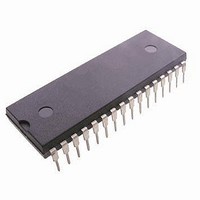GLS29EE010-70-4C-PHE Greenliant, GLS29EE010-70-4C-PHE Datasheet - Page 2

GLS29EE010-70-4C-PHE
Manufacturer Part Number
GLS29EE010-70-4C-PHE
Description
EEPROM 128K X 8 70ns
Manufacturer
Greenliant
Datasheet
1.GLS29EE010-70-4C-PHE.pdf
(28 pages)
Specifications of GLS29EE010-70-4C-PHE
Organization
128 K x 8
Access Time
70 ns
Supply Voltage (max)
5.5 V
Supply Voltage (min)
4.5 V
Maximum Operating Current
20 mA
Maximum Operating Temperature
+ 70 C
Mounting Style
Through Hole
Minimum Operating Temperature
0 C
Operating Supply Voltage
4.5 V to 5.5 V
Memory Size
1 Mbit
Package / Case
PDIP-32
Lead Free Status / RoHS Status
Lead free / RoHS Compliant
Available stocks
Company
Part Number
Manufacturer
Quantity
Price
Company:
Part Number:
GLS29EE010-70-4C-PHE
Manufacturer:
Greenliant
Quantity:
77
Data Sheet
Read
The Read operations of the GLS29EE010 is controlled by
CE# and OE#, both have to be low for the system to obtain
data from the outputs. CE# is used for device selection.
When CE# is high, the chip is deselected and only standby
power is consumed. OE# is the output control and is used
to gate data from the output pins. The data bus is in high
impedance state when either CE# or OE# is high. Refer to
the Read cycle timing diagram for further details (Figure 5).
Write
The Page-Write to the GLS29EE010 should always use
the JEDEC Standard Software Data Protection (SDP)
three-byte command sequence. The GLS29EE010 con-
tains the optional JEDEC approved Software Data Protec-
tion scheme. Greenliant recommends that SDP always be
enabled, thus, the description of the Write operations will
be given using the SDP enabled format. The three-byte
SDP Enable and SDP Write commands are identical;
therefore, any time a SDP Write command is issued,
Software Data Protection is automatically assured. The
first time the three-byte SDP command is given, the device
becomes SDP enabled. Subsequent issuance of the same
command bypasses the data protection for the page being
written. At the end of the desired Page-Write, the entire
device remains protected. For additional descriptions,
please see the application notes, The Proper Use of
JEDEC Standard Software Data Protection and Protecting
Against Unintentional Writes When Using Single Power
Supply Flash Memories.
The Write operation consists of three steps. Step 1 is the
three-byte load sequence for Software Data Protection.
Step 2 is the byte-load cycle to a page buffer of the
GLS29EE010. Steps 1 and 2 use the same timing for both
operations. Step 3 is an internally controlled Write cycle for
writing the data loaded in the page buffer into the memory
array for nonvolatile storage. During both the SDP three-
byte load sequence and the byte-load cycle, the addresses
are latched by the falling edge of either CE# or WE#,
whichever occurs last. The data is latched by the rising
edge of either CE# or WE#, whichever occurs first. The
internal Write cycle is initiated by the T
rising edge of WE# or CE#, whichever occurs first. The
Write cycle, once initiated, will continue to completion, typi-
cally within 5 ms. See Figures 6 and 7 for WE# and CE#
controlled Page-Write cycle timing diagrams and Figures
16 and 18 for flowcharts.
©2010 Greenliant Systems, Ltd.
BLCO
timer after the
2
The Write operation has three functional cycles: the Soft-
ware Data Protection load sequence, the page-load cycle,
and the internal Write cycle. The Software Data Protection
consists of a specific three-byte load sequence that allows
writing to the selected page and will leave the
GLS29EE010 protected at the end of the Page-Write. The
page-load cycle consists of loading 1 to 128 bytes of data
into the page buffer. The internal Write cycle consists of the
T
Write operation, the only valid reads are Data# Polling and
Toggle Bit.
The Page-Write operation allows the loading of up to 128
bytes of data into the page buffer of the GLS29EE010
before the initiation of the internal Write cycle. During the
internal Write cycle, all the data in the page buffer is written
simultaneously into the memory array. Hence, the Page-
Write feature of GLS29EE010 allows the entire memory to
be written in as little as 5 seconds. During the internal Write
cycle, the host is free to perform additional tasks, such as
to fetch data from other locations in the system to set up
the write to the next page. In each Page-Write operation, all
the bytes that are loaded into the page buffer must have
the same page address, i.e. A
loaded with user data will be written to FFH.
See Figures 6 and 7 for the Page-Write cycle timing dia-
grams. If after the completion of the three-byte SDP load
sequence or the initial byte-load cycle, the host loads a
second byte into the page buffer within a byte-load cycle
time (T
page-load cycle. Additional bytes are then loaded consecu-
tively. The page-load cycle will be terminated if no addi-
tional byte is loaded into the page buffer within 200 µs
(T
WE# or CE# high-to-low transition after the last rising edge
of WE# or CE#. Data in the page buffer can be changed by
a subsequent byte-load cycle. The page-load period can
continue indefinitely, as long as the host continues to load
the device within the byte-load cycle time of 100 µs. The
page to be loaded is determined by the page address of
the last byte loaded.
Software Chip-Erase
The GLS29EE010 provides a Chip-Erase operation, which
allows the user to simultaneously clear the entire memory
array to the “1” state. This is useful when the entire device
must be quickly erased.
The Software Chip-Erase operation is initiated by using a
specific six-byte load sequence. After the load sequence,
the device enters into an internally timed cycle similar to the
BLCO
BLCO
) from the last byte-load cycle, i.e., no subsequent
1 Mbit Page-Write EEPROM
time-out and the write timer operation. During the
BLC
) of 100 µs, the GLS29EE010 will stay in the
7
through A
S71061-15-001
GLS29EE010
16
. Any byte not
05/10












